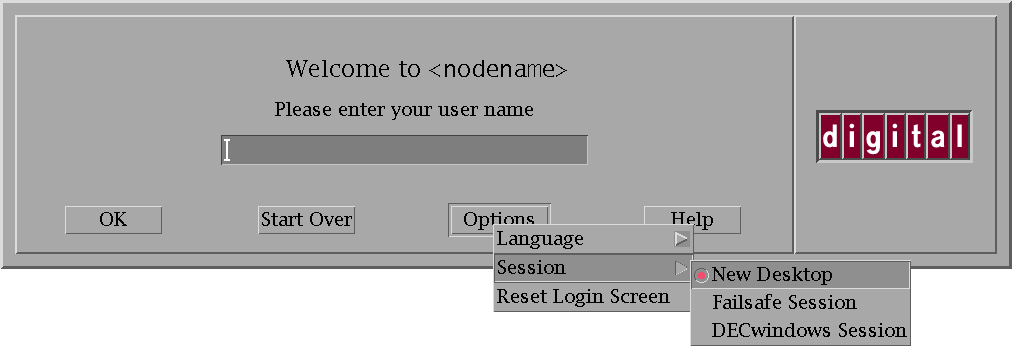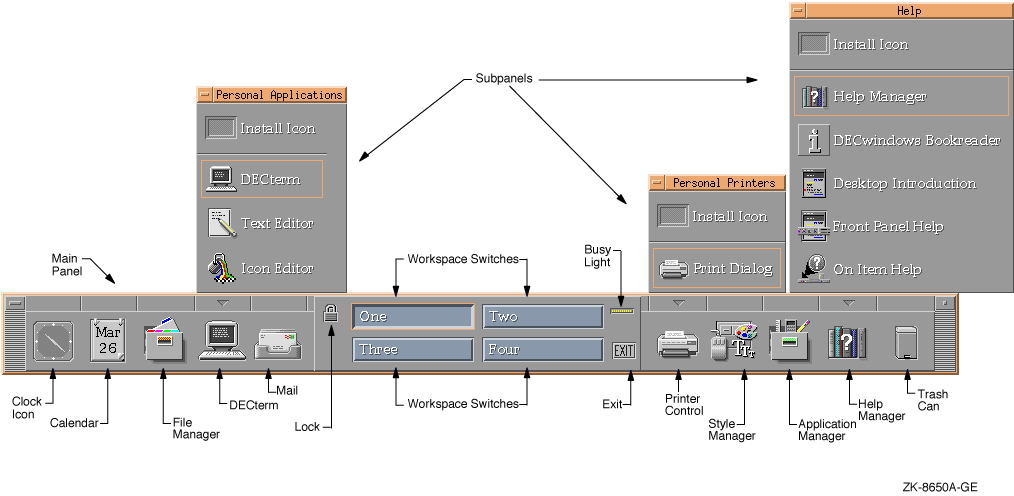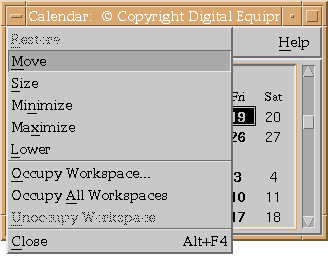Chapter 2
Using the New Desktop
This chapter provides information about the following topics:
- CDE user applications in the New Desktop (Section 2.1)
- Accessing DECwindows applications (Section 2.2)
- Making applications more accessible (Section 2.3)
- CDE user documentation (Section 2.4)
2.1 CDE User Applications in the New Desktop
The CDE user applications that are included in the New Desktop are
briefly described in this section. The focus of these descriptions is
on
the differences that users accustomed to the DECwindows desktop
applications
might experience. Differences between CDE on UNIX systems and
the New Desktop are described in Appendix A.
2.1.1 Login Manager
The login manager provides login and authentication processing for the New Desktop in a manner similar to the login box provided with the traditional DECwindows desktop. In addition to user authentication, it also provides several options, as shown in Figure 2-1. Figures 2-1 Login Dialog Box

From the Options pull-down menu you can select:
- Language of the user interface
- Type of session you want
- Whether to reset the login screen
You can select from the following session types:
- New Desktop session
New Desktop is the default environment. - Failsafe session
A failsafe session is a limited, single-DECterm window environment that allows you to correct startup problems in other environments. - DECwindows session
A DECwindows session is the traditional DECwindows environment.
Resetting the login screen is useful if you want to take advantage of
customizations made to the login screen or, in an X terminal
environment,
if you want to remove the login box and terminate login processing.
2.1.2 Front Panel
The Front Panel, shown in Figure 2-2, provides quick access to applications and many other features. This section describes some aspects of the Front Panel that may not be immediately apparent to users accustomed to the DECwindows desktop. Here are some details to help you get started. Figures 2-2 Front Panel Details

- Moving the Front Panel
Position the cursor on the left or right border and press MB1 to move the Front Panel. The Front Panel can be moved up and down but cannot be rotated. - A single click on any application icon (except Clock) starts the application.
- Getting information about each icon
Position the cursor on any icon and press mouse button 3 (MB3) to either get help about the icon or add or delete a subpanel. - Clock icon
The clock displays the current time. However, unlike the other Front Panel controls, the clock is not a separate application. It is part of the Window Manager and can be customized by editing the date control definition in the Front Panel configuration file. (Refer to the Common Desktop Environment: Advanced User's and System Administrator's Guide for instructions.) The DECwindows Clock application can be accessed from Application Manager's DECwindows Apps group. - Arrows above icons
The arrows indicate that a subpanel, or menu, is available. Position the cursor on any arrow and single click. A subpanel is displayed with an Install Icon item that enables you to add applications to the menu. To close the subpanel, position the cursor on the same arrow, which now faces down, and single click on it. - Moving a subpanel
You can move any subpanel with mouse button 1 (MB1). Position the cursor on the subpanel menu bar, press and hold MB1, drag the subpanel to a new location, and release MB1. - Relationship of Front Panel to workspaces
You can have as many as 64 different workspaces. The Front Panel is the same for all workspaces and is displayed on each workspace. - Relationship of applications to workspaces
You can put the same application in more than one workspace. For example, you can put the Text Editor in two workspaces and the clock in every workspace. You do this by selecting either Occupy Workspace... or Occupy All Workspaces from the Window menu, shown in Figure 2-3. (You can access an application's Window menu by clicking on the control in the top left corner of its main window.) - Managing workspaces
Pressing MB3 on a workspace control button displays a menu that enables you to add, delete, or rename workspaces.

2.1.3 Application Manager
Application Manager is a repository for applications and tools available on a system. It supports application groups---those provided with the New Desktop (shown in Table 2-1) and those you create (see Section 4.4).
To view the Application Manager window, single click on the Application Manager icon, shown in Figure 2-2. From the Application Manager screen, you can select a group by double clicking on its icon. A screen with icons representing each application in the group is displayed. From this screen, you can start any application by double clicking on its icon.
| Group | Contents |
|---|---|
| DECwindows Apps | Applications such as DECwindows Mail, Calendar, FileView, Cardfiler, and all other DECwindows applications supplied with DECwindows Motif prior to Version 1.2--4 |
| DECwindows Utilities | Most of the standard X utilities |
| Desktop Apps | CDE applications |
| Desktop Tools | Tools for common user tasks, such as comparing files, showing logical names, and viewing images |
For more information about Application Manager, see its online help and
the
Common Desktop Environment: User's Guide.
2.1.4 Calculator
The New Desktop's Calculator application offers the following features:
- Three modes: Scientific (default), Logical, and Financial.
- Three trigonometric bases in Scientific mode.
- Four numeric bases: decimal, octal, hexadecimal, and binary.
- Ten memory registers for storing values, for use in each mode. The values can be recalled and exchanged between a specified register and the display area.
You can access the New Desktop's Calculator from the Personal Applications subpanel. For more information about it, access its help.
The DECwindows desktop Calculator is still available. You can access
it
from the DECwindows Apps group in Application Manager.
2.1.5 File Manager
File Manager presents an iconic representation of files.
It allows intuitive user actions, such
as dragging and dropping files. It also allows files to be placed on
the
background of the screen for fast access. You can open several views
of different directories or of the same directory.
2.1.5.1 File Representation
File Manager supports four different representations of files:
- Large icons
- Small icons
- File name only
- Hierarchical tree view
You can choose the representation you prefer. If you frequently navigate up and down your directory tree, you may prefer the hierarchical directory view.
All executable programs and all command procedures, when invoked from File Manager by clicking on files with a .EXE or .COM extension, will be started with an associated DECterm window to capture output. A DECterm window is created regardless of the type of executable program or command procedure. If you do not want the DECterm window to appear, which is usually the case, you must create a new action definition file and an associated action (stub) file for invoking the executable or the command file. See Section 4.1 for information about creating action definition files and action files.
2.1.5.2 File Filtering and Sorting
Files can be filtered and sorted by several criteria. To set filtering options, select View from the File Manager menu bar; then, from the View menu, select Set Filter Options. Filters for various data types can be turned on or off. For example, you can choose to view only files of the type COM_FILE or all files except files of the type COM_FILE (see Section 3.4.2.1). The filtering options also allow filtering by an explicit file type (for example, .RDB) and filtering by file name versions. You can choose to see all versions of your files or only the highest version.
To set sorting criteria, select View from the File Manager menu bar, then select Set View Options. You can choose to sort alphabetically, by data type, by modification date, or by size.
For more information about the capabilities of File Manager,
see its online help, the Common Desktop Environment: User's
Guide, and the Common Desktop Environment: Administrator's
Guide.
2.1.6 Trash Can
File Manager supports dropping files on the Trash Can icon. Files that
are
moved to the Trash Can are not actually deleted and are still counted
in
your disk quota. To delete a file, you must shred the
contents of the Trash Can. If the Trash Can contents have not been
shredded,
the files can be moved back to their original directory.
2.1.7 Help Viewer
Help Viewer, accessible from the Front Panel (see Figure 2-2) and from every CDE application, presents the help for all CDE applications within the New Desktop. In addition to application help, several other types of help are available, including Help on Help, Desktop Introduction, and On Item Help.
To use On Item Help, select it from the Help subpanel, position the cursor on the item for which you want help, and single click. Help is displayed in a full-size window.
For more information about the Help Viewer, see the
online help and the Common Desktop Environment: User's
Guide.
2.1.8 Icon Editor
The Icon Editor, accessible from the subpanel above the DECterm icon, enables you to create new icons or edit existing ones. You can resize icons, add hotspots to icons, and grab screen images and edit them.
For more information about Icon Editor, see its
online help and the Common Desktop Environment: User's
Guide.
2.1.9 Print Dialog
The printer icon on the Front Panel (see Figure 2-2) is configured to access the default printer for the desktop. The default printer is defined by the value of the SYS$PRINT logical on the system.
You can select different print job options for the default printer by using the Print Dialog. To access the Print Dialog, click on its icon on the Front Panel.
To print a file using the default printer and the options specified for it, drag the icon of the file you want to print and drop it on the Print Dialog icon.
If you would like to use a different printer as your default printer,
see
Section 3.4.5.
2.1.10 Text Editor
The Text Editor, accessible from the subpanel above the DECterm icon, is a full-function editor. It offers the standard text editing functions as well as more advanced features, including the drag-and-drop function. The drag-and-drop function can be used for moving text, copying text, and including entire files in another file.
If you would like to use a different editor as your default editor, see
Section 3.4.6.
2.1.11 Session Manager
Session Manager functions are available from the Startup menu within Style Manager. From the Startup menu, you can select the application configuration of your next session. The Startup menu options are shown in Table 2-2.
| Option | Description |
|---|---|
| Resume current session | The next time you log in, your session will start up where you left off when you logged out---as close as possible to the current configuration. |
| Return to home session | The next time you log in, your session will start up with a configuration that you have defined as your home session. If you have not defined a home session, the system default session is used. |
| Ask me at Logout | When you log out, you will be prompted to return to your current session or your home session. |
| Logout Confirmation Dialog | You can specify whether you want to be prompted to confirm your intent to log out. |
| Set Home Session | You can select your current session as your home session. You can do this at any time during a session. Customizations that you made during the session are included. |
2.1.12 Style Manager
Style Manager enables you to control the following components of your desktop environment:
- Font size
- Backdrops (for each workspace)
- Keyboard attributes, including the language variant and clicking characteristics
- Mouse attributes
- Beep characteristics
- Screen characteristics, including blanking and backdrop to be used when the screen is locked
- Window behavior, including how to make windows active (by pointing or clicking)
- Startup attributes, as described in Section 2.1.11
- Security, which establishes the authorized users of your desktop
2.2 Accessing DECwindows Applications
All the applications provided with the previous release of DECwindows Motif are included with the New Desktop. By default, some of them are accessible from the Front Panel and all of them are accessible from Application Manager. The applications that are accessible from the Front Panel are:
- Calendar
- DECterm
You can also access DECwindows applications from a DECterm. All optional DECwindows applications (those purchased separately) can also be accessed from a DECterm.
The access methods are described in Table 2-3.
| Location | Method |
|---|---|
| Front Panel | Single click on the icon or on the selection from a subpanel. |
| Application Manager | Single click on the Application Manager icon on the Front Panel; then double click on the icon for its group; then double click on its icon. |
| DECterm | Run the application by its system-defined name. |
2.3 Making Applications More Accessible
You can make an application not already located in Application Manager or the Front Panel more accessible. You can do this by dragging its default icon (a lightning bolt with its file name displayed below it) from the File Manager display and dropping it on any of the following locations:
- New application group in Application Manager
- Front Panel, on the Install Icon control of the Personal Applications subpanel (a new control will be created in the subpanel)
- Desktop (the background of a workspace)
After you move an application icon to one of these locations, you can invoke it from there.
Although moving an icon in this way makes the application more accessible, it does not provide the same level of integration that is available with the applications that are part of the New Desktop. For example, the application does not have a unique icon, and each time you invoke the application, a new DECterm is created. You can select a different icon from the set provided with the New Desktop or create a new one; you can eliminate the DECterm if it is not needed; and you can supply any arguments you want specified automatically if you integrate the application into the New Desktop.
For information about minimal integration, see Section 4.1. For
information about creating new application groups, see
Section 4.4.
2.4 CDE User Documentation
The CDE components of the New Desktop are documented in an extensive help system and in CDE manuals, which are available in print (separately orderable; see Section 1.8.1). The CDE manuals (and this manual) are also in HTML format on the DECwindows Motif Version 1.2--4 for OpenVMS CD--ROM. You can view these manuals with the Enhanced Mosaic web browser that is included on the same CD-ROM (see Section 1.8.2).
The following CDE user manuals are provided:
- Common Desktop Environment: User's Guide
- Common Desktop Environment: Glossary
- Common Desktop Environment: Advanced User's and System Administrator's Guide
Chapter 3
Managing the New Desktop
This chapter provides information about the following topics:
- DECwindows and the New Desktop startup sequence (Section 3.1)
- Changing the default desktop (Section 3.2)
- New Desktop directory hierarchy (Section 3.3)
- Customizing the environment and applications (Section 3.4 )
- Using the New Desktop error logs (Section 3.5)
- Using colors in the New Desktop environment (Section 3.6)
- Using the New Desktop fonts (Section 3.7)
- Using X terminals and other remote displays (Section 3.8)
- Using multiple screens (Section 3.9)
- Managing processes created within the New Desktop (Section 3.10)
- CDE system management documentation (Section 3.11)
3.1 DECwindows and the New Desktop Startup Sequence
SYS$MANAGER:DECW$STARTUP.COM, the DECwindows startup command procedure, can start either the traditional DECwindows desktop or the New Desktop. On OpenVMS Alpha, the New Desktop is started by default.
SYS$MANAGER:CDE$STARTUP.COM is executed during the application startup phase of the New Desktop to perform the following steps:
- Define a series of logical names used by the New Desktop.
- Install several executables (login) and libraries used by the New Desktop.
Once login starts, login starts Session Manager, which
in turn starts Window Manager for the session. For a complete
description of
the DECwindows login process, see Managing DECwindows Motif for
OpenVMS Systems.
3.2 Changing the Default Desktop
You can change the default desktop from the New Desktop to the DECwindows desktop by modifying the SYS$MANAGER:DECW$PRIVATE_APPS_SETUP.COM file and restarting the desktop.
To change the default desktop to the DECwindows desktop, perform the following steps:
- If you do not already have a SYS$MANAGER:DECW$PRIVATE_APPS_SETUP.COM file, create one by copying SYS$MANAGER:DECW$PRIVATE_APPS_SETUP.TEMPLATE to a new file, SYS$MANAGER:DECW$PRIVATE_APPS_SETUP.COM.
- Define the global symbol DECW$START_NEW_DESKTOP as FALSE in
SYS$MANAGER:DECW$PRIVATE_APPS_SETUP.COM:
$ DECW$START_NEW_DESKTOP == "FALSE"
- Restart the desktop with the following command:
$ @SYS$MANAGER:DECW$STARTUP RESTART
If the DECwindows desktop is running and you want to change the default back to the New Desktop, perform the same steps but define DECW$START_NEW_DESKTOP as TRUE instead of FALSE.
If you want to be able to select either desktop when you log in, do not
modify the global symbol DECW$START_NEW_DESKTOP. Instead, select the
desktop
you want when you log in, using
the Login Manager's Options menu, as described in Section 2.1.1.
3.3 New Desktop Directory Hierarchy
The New Desktop uses a fairly complex directory hierarchy for all of the files required for its environment. To traverse these directories and access these files, the New Desktop uses search paths to indicate the location and search order of these files for various operations. These search paths are logical names that contain a list of directory specifications and are defined when the New Desktop is started.
In general, three locations are searched for any data file. The locations and the order in which they are searched are shown in the following list:
- disk$:[user.DT...]
User-specific directory in the user's home directory. - CDE$USER_DEFAULTS:[*...] (customizable)
Systemwide directory that can be customized by the system manager. - CDE$SYSTEM_DEFAULTS:[*...] (noncustomizable)
Systemwide directory where the default copies of all of the files are placed at installation time.
This means that files found in a user-specific directory take precedence over files in a systemwide customizable directory, which take precedence over the files in the systemwide installed directory.
The CDE$USER_DEFAULTS directory hierarchy is not created at installation. If you need to add any systemwide customizations, you must create the corresponding directories.
3.3.1 System Default Configuration Directories
CDE$SYSTEM_DEFAULTS:[*...] is the system directory hierarchy of the New Desktop. It contains read-only directories, which contain resource, application defaults, configuration, and application support files, as shown in Figure 3-1 and described in Table 3-1. These files should not be edited because future installations will overwrite the files. Furthermore, applications should never create files in these directories, although they can read and execute the files. Figures 3-1 CDE$SYSTEM_DEFAULTS Directory Hierarchy

3.3.2 Directory Hierarchy With Multiple Locales
The [.C] directories shown in Figure 3-1 contain locale-specific files required for running the default C locale installed on your system. For each additional locale installed, a corresponding directory at the same level as each [.C] directory is present. For example, if the French locale is also installed on your system, the directory hierarchy of [.APP-DEFAULTS] will show both [.C] and [.FR_FR_ISO8859-1] directories. Files specific to the French locale are placed in the [.FR_FR_ISO8859-1] directories and are accessed before the files with the same name in the [.C] directories.
| Directory | Contents |
|---|---|
| [.APPCONFIG] | Application management, help, example, icon, and datatype definition files, which include Front Panel configuration files. The [.APPMANAGER] directory contains several subdirectories, each corresponding to a different application group. Each subdirectory contains action (stub) files, one for each application in that group. |
| [.APP-DEFAULTS] | Application default (resource) files for applications provided by the New Desktop. |
| [.BACKDROPS] | Backdrops provided with the New Desktop. |
| [.BIN] | New Desktop executable (binary) files. |
| [.CONFIG] | System configuration files for global resource settings for various aspects of the New Desktop, such as Session Manager and Window Manager resources. Font alias files are contained within the [.XFONTS] subdirectory hierarchy. |
| [.EXAMPLES] | Example files that show how to use CDE programming resources. |
| [.LIB] | Localized message catalog files. |
| [.MAN] | Unmodified, preprocessed UNIX manpages for the New Desktop. |
| [.PALETTES] | Color palettes provided with the New Desktop. |
3.3.3 Configuration Directories for Systemwide Customizations
The following directory hierarchy is the systemwide configuration directory for the New Desktop:
CDE$USER_DEFAULTS:[*...]
All directories listed in Table 3-1 can have a corresponding directory in the CDE$USER_DEFAULTS:[*...] hierarchy. Systemwide customizations should be made by first copying the file to be customized from its CDE$SYSTEM_DEFAULTS location to the same directory in the CDE$USER_DEFAULTS hierarchy and then editing the file. You may need to create the destination directory.
The CDE$USER_DEFAULTS logical is a search path containing the logicals CDE$USER_SPECIFIC and CDE$USER_COMMON. Node-specific changes should be placed in the appropriate subdirectory of the CDE$USER_SPECIFIC:[*...] hierarchy. Clusterwide changes should be placed in the appropriate subdirectory of the CDE$USER_COMMON:[*...] hierarchy.
Table 3-2 describes how to customize a system default for a node or a cluster.
| System Type | Directions |
|---|---|
| Node | Copy the file containing the default value you want to change from its directory under CDE$SYSTEM_DEFAULTS to the same directory under CDE$USER_SPECIFIC and edit it. |
| Cluster | Copy the file containing the default value you want to change from its directory under CDE$SYSTEM_DEFAULTS to the same directory under CDE$USER_COMMON and edit it. |
Next page... | Contents